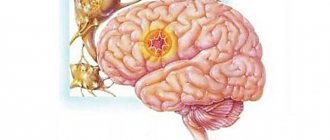Over the 150 years that medicine has known this disease, the disease itself has changed, and its treatment has become completely different. Today, doctors advise patients to perceive this diagnosis not as a death sentence with a short delay, but as a challenge. Because with multiple sclerosis you can live life to the fullest. You just need to gain strength and patience.
Our experts:
President of the All-Russian Public Organization of Disabled People with Multiple Sclerosis, Chairman of the Council of Public Organizations for the Protection of Patients' Rights under Roszdravnadzor Yan Vlasov.
Professor of the Department of Neurology of the First St. Petersburg State Medical University. acad. I. P. Pavlova Natalya Totolyan .
Myth No. 1. Only old people get multiple sclerosis. This is a condition associated with memory loss
In fact . This disease is not associated with atherosclerosis (and serious memory impairment is a very rare symptom). Multiple sclerosis is a progressive pathology of the central nervous system. It develops as a result of autoimmune inflammation with damage to the myelin sheaths of nerve fibers, which gradually leads to the death of nerve cells. During exacerbations, multiple scattered foci of inflammation and sclerosis (scarring) form in the brain and spinal cord, which manifests itself in new symptoms or intensification of old ones.
Most often, multiple sclerosis begins at a young age (25-40 years), up to 10% - in children. Around the world, 2.5 million people suffer from this disease. In Russia, according to official data, there are 90 thousand (according to unofficial data, 150 thousand). On average, the annual increase in patients is 7%.
You're lying, you won't take it! New in the treatment of multiple sclerosis Read more
Why does multiple sclerosis happen?
The causes that contribute to the occurrence of multiple sclerosis are not yet fully known. The myelin sheath, due to external and internal influencing factors, can be subject to destruction, so signals through neurons are transmitted slowly or the conduction of impulses is completely absent.
The supposed cause of the development of MS is a malfunction of the immune system, which, instead of fighting foreign cellular structures, destroys its own. Scars will appear on the nerves, signals from internal organs to the brain and back will be blocked. The patient loses control over movements, the sensitivity of the limbs decreases, and speech becomes slow.
There are known circumstances due to which pathology can occur:
- burdened heredity, when genes mutate over a generation;
- prolonged nervous overstrain in young men and women;
- people often experience infections caused by bacteria and viruses;
- deficiency of vitamin D, which is less synthesized by the body due to lack of sunlight;
- frequent injuries;
- poor nutrition;
- frequent smoking;
- decreased uric acid parameter;
- vaccination against hepatitis B.
Other signs of pathology appear due to unfavorable environmental conditions (high levels of toxic substances, radiation), which are especially dangerous for children.
The pathology is caused by the NTU-1 virus (or a similar virus), which disrupts immune regulation, inflammation develops, and myelin neuron sheaths disintegrate.
Myth No. 2. The main symptom of multiple sclerosis is problems walking.
In fact . Multiple sclerosis is called the disease with a thousand faces. Often the first sign may be blurred vision in one eye, numbness in an arm or leg, headaches and dizziness, and problems with coordination. Sometimes it's just increased fatigue or problems holding urine. Therefore, internists, ophthalmologists and urologists are often the first to encounter the disease. It is sometimes difficult to recognize a disease early, so special schools of neurologists are regularly held, where doctors are taught to be alert to a variety of symptoms that this disease may signal.
Until recently, diagnosis was delayed for 5-8 years. Today in Russia the situation has improved dramatically due to the fact that the community of neurologists and public organizations studying multiple sclerosis are conducting educational activities on this problem. However, the disease can be completely asymptomatic for several years. In this case, it can only be detected with magnetic resonance imaging (MRI), which shows altered areas on tomograms of the brain or spinal cord. The neurology community even proposed to the Ministry of Health to introduce screening for multiple sclerosis from childhood. But MRI is an expensive method, so such screening is not yet available.
Causes of multiple sclerosis
Multiple sclerosis is classified as an autoimmune disease in which, as a result of certain disorders, the body's immune system begins to destroy its own cells.
Antibodies produced by lymphocytes, in this case, attack the myelin sheath of nerve fibers, as a result of which the inflammatory process is activated and the myelin tissue is replaced by connective tissue.
Although the final causes of multiple sclerosis have not yet been precisely determined, most scientists are inclined to believe that the disease is activated as a result of a combination of genetic predisposition and negative external factors.
Causes of multiple sclerosis in adults
A disturbance in the immune system, or rather, an inadequate response to some viral and bacterial infections, is also not discounted by many authors.
In addition, the prerequisites contributing to the development of this pathological condition include:
- Impact of toxins on the human body;
- Increased background radiation levels;
- The influence of ultraviolet radiation (in white-skinned lovers of the annual “chocolate” tan obtained in southern latitudes);
- Geographical location of the area of permanent residence (cold climatic conditions);
- Permanent psycho-emotional stress;
- Surgical interventions and injuries;
- Allergic reactions;
- No apparent reason;
- There is a genetic factor that I would like to especially focus on.
Multiple sclerosis is classified as an autoimmune disease in which, as a result of certain disorders, the body's immune system begins to destroy its own cells.
Antibodies produced by lymphocytes, in this case, attack the myelin sheath of nerve fibers, as a result of which the inflammatory process is activated and the myelin tissue is replaced by connective tissue.
Although the final causes of multiple sclerosis have not yet been precisely determined, most scientists are inclined to believe that the disease is activated as a result of a combination of genetic predisposition and negative external factors.
Myth No. 3. Only an MRI of the head can confirm the diagnosis.
In fact . The main methods for diagnosing multiple sclerosis are clinical manifestations in combination with MRI data and cerebrospinal fluid (CSF) analysis. To analyze the CSF, a lumbar puncture is made, 1-2 ml of fluid is obtained and tested for oligoclonal immunoglobulins - their presence confirms the inflammatory process. These tests are safe and recommended in most cases for early diagnosis. There are also additional instrumental studies: evoked potential techniques, coherent optical tomography and others.
Complications and life expectancy
How long people with multiple sclerosis live depends largely on how one treats the appearance of pathology. It is not without reason that it is noted that thoughts are material. If you recognize only the negative aspects of the situation, then the progression of the disease is inevitable.
The appearance of various complications is possible within 5–7 years from the onset of dimyelization. The urinary system is most often affected. In patients, pyelonephritis and cystitis worsen, and urinary incontinence or retention is observed. Against this background, blood pressure parameters fluctuate - it either increases sharply and persistently, without the effect of antihypertensive drugs, or decreases just as quickly.
Poor health leads to increased internal discord - psychological problems often accompany multiple sclerosis. With the rapid progression of the disorder due to depressive conditions, people make suicide attempts.
Paresis and paralysis lead to immobilization of the patient and the development of necrosis in the tissues - bedsores. They themselves will be entry points for infections. If left untreated, death occurs from sepsis. The fight against complications should begin at the stage of their possible appearance. After all, the best treatment is, of course, prevention.
Myth No. 4. The cause of the disease is viruses
In fact . Multiple sclerosis, like most chronic diseases, is a multifactorial pathology. A number of factors that provoke the disease cannot be influenced, but we can eliminate some (the so-called modifiable factors), thereby reducing the risk of MS and its more severe course.
Science knows of numerous hereditary factors of predisposition to MS (however, there are also genes that protect against the disease). The risk is also increased by an unfavorable environment, smoking, excess salt in the diet, deficiency of sunlight and vitamin D. Numerous studies in recent years also indicate the role of changes in the composition of the intestinal microflora in the development of autoimmune inflammation and even damage to nerve cells in MS.
“Untimely encounters” with some viruses also play a role. For example, the risk of developing multiple sclerosis increases later infection (in adolescence and older age) with the Epstein-Barr virus, which is accompanied by infectious mononucleosis. Some retroviruses, which at the dawn of the evolution of the animal world were “inscribed” in our genome, subsequently left their “messages” in our genes, which also contribute to the development of MS. In addition, patients with this disease are known to have an initially impaired immune response to some viruses.
Sclerosis, but not that one. By what signs are multiple pathologies recognized? Read more
Causes and provoking factors
Doctors have yet to determine the true cause of the development of multiple sclerosis in people. Today, only the role of immune mechanisms in the demyelinating process is obvious - the white matter of brain structures is more susceptible to damage.
Prerequisites for triggering an autoimmune failure:
- age factor - young people under 25–30 years of age are affected, less often signs of a nervous disorder are detected after 50–55 years of age;
- heredity - if there have already been cases of multiple sclerosis in the family, then the risk that the pathology will manifest itself in subsequent generations is high;
- suffered acute severe psycho-emotional shocks or chronic stressful situations;
- infectious lesions of brain structures that occurred with complications - meningitis, encephalitis;
- deficiency of vitamin D in the body;
- unfavorable environmental conditions - if a person lives in a metropolis for a long time, then the risk of developing MS is higher.
Statistically, multiple sclerosis affects both men and women equally. However, representatives of the fairer sex have a more fragile structure of the nervous system, so their incidence is higher. As a rule, in order for a pathology to form, exposure to several provoking factors is required.
Myth No. 6: Multiple sclerosis is incurable. All you have to do is come to terms with it
In fact . At the moment, this disease cannot be cured, but most often it can be controlled. Over the past decade, the lives of patients with multiple sclerosis have changed dramatically. With the advent of several generations of drugs, the so-called DMTs (drugs that modify the course of multiple sclerosis), doctors have the opportunity not only to alleviate symptoms, but to prevent exacerbations and subsequent disability. The number of such drugs is growing every year.
Average lifespan
The constant development of the medical industry allows people to hope that they will be able to live with multiple sclerosis for at least another 20–30 years after confirmation of the preliminary conclusion of neurologists. Death, as a rule, occurs not from the pathology itself, but from accompanying complications - for example, pneumonia, sepsis. Whereas with appropriate therapy, life expectancy is much longer.
According to the potential timing of death, people with multiple sclerosis can be divided into several subgroups:
- early onset of symptoms with timely prescribed medication regimens - patients live only 5–7 years less than their peers;
- late onset of neurological disorders, after 50 years, but adequate treatment measures allow you to live up to 70–75 years;
- late onset of pathology combined with rapid progression of complications - people can cross the 60-year mark, but are deeply disabled;
- The development of pathology is rapid - after differential diagnosis and even with active treatment procedures, people die at 8–10 years of the pathological process.
If zones of demyelination begin to appear before the age of 20–25 and periods of remission are long, thanks to the full pharmacological effect, then the chances that the patient will see his grandchildren are higher.
Myth #7: Multiple sclerosis medications suppress the immune system. Therefore they are very harmful and dangerous
In fact . All PEDs suppress not immunity, but immune inflammation. There are 1st line drugs, which include milder drugs (immunomodulators), as well as 2nd line drugs - selective immunosuppressants that selectively affect the immune system, reducing its autoaggression. Not all DEDs need to be taken constantly. There are drugs whose treatment course lasts only a few days a year, but the effect can last for a very long time if the treatment was timely.
Innovations to extend life
Dimyelization of the nerve fiber does not spare anyone - there are known cases of early onset of multiple sclerosis in children. Pregnancy can serve as an impetus for the development of the pathological process. Therefore, scientific work to create an effective medicine is being carried out by doctors all over the world.
Thus, Russian specialists have developed a vaccine against multiple sclerosis based on liposomes. They are able to stop the aggression of lymphocytes on myelin. The research results confirm the effectiveness and good tolerability of the drug in volunteers.
An innovative approach is the use of the patient’s own stem cells. They are isolated from biomaterial obtained from tissues before the start of powerful immunosuppressive therapy. The stem cells grown in the laboratory are then reintroduced into the patient’s body. The answer is an improvement in well-being and restoration of motor activity due to the correction of the myelin sheath of the nerve fiber.
Multiple sclerosis is not a death sentence at all. It can and should be dealt with, but in close cooperation with the treating neurologist.
Myth No. 8. Innovative medicines are not available to Russian patients
In fact . All innovative drugs for multiple sclerosis registered in the world are available to Russian patients. Patients can receive most DMTs free of charge: multiple sclerosis is included in the list of nosologies for which centralized preferential provision of drugs is provided. The latest drugs become available in Russia with a delay of 2-3 years, but doctors even find advantages in this fact. This delay allows the development of measures to prevent possible complications of therapy, which are identified precisely in the first years of widespread use of the new drug.
Broken bike. How do people with multiple sclerosis feel? More details
What shortens life expectancy with multiple sclerosis?
Of course, life with multiple sclerosis is more difficult, but no more than with any other neurological disorder. It is quite possible to learn to get along with him. The secret of long-livers is simple - fulfilling all doctor’s prescriptions, as well as completely eliminating negative factors.
Thus, it has been observed that stress greatly reduces the area of healthy cells in brain structures. For example, negative emotions accelerate the progression of demyelination and increase the number of affected areas in the nervous system. In addition, stressful situations serve as a platform for new exacerbations if the pathology was in a state of regression.
An uncorrected diet has a negative effect. In order for cells to transmit nerve impulses normally, they must receive the necessary microelements and vitamins. A complete diet is dominated by vegetables and various fruits, cereal porridges and dairy products. Whereas heavy, fatty, fried foods, as well as preservatives, smoked meats and sauces should be avoided.
The average length of a full life is shortened by the lack of support from loved ones and friends. If the patient is forced to coexist with multiple sclerosis, then poor personal hygiene, monotonous nutrition, and depressive states will lead to an acceleration of pathological changes in the nervous system.











